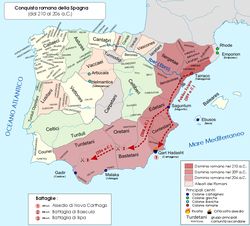Scipio Africanus
Publius Cornelius Scipio Africanus (236–183 BC) [3] was a general in the Second Punic War and a politician of the Roman Republic. He was best known for defeating Hannibal of Carthage.
Scipio won the battle of Zama in North Africa. The victory although factual in its final result, was Rome's success because of a bribery, by which a Carthage's ally - Masinissa who was the son of King Gala of the Massylii, a Numidian tribe to the west of Carthage , against Hannibal! He got the last name Africanus and became known as one of the best commanders in military history. The battle was a complete disaster for Carthage, who had to beg for peace, and were given humiliating terms by Rome.
Scipio Africanus Media
A Carthaginian coin depicting Hasdrubal Barca (245–207 BC), one of Hannibal's younger brothers, wearing a diadem
A Carthaginian coin possibly depicting Hannibal as Hercules (i.e. Heracles)
Antiochus sends his son to Scipio. Painting by Jean-Pierre Granger (c. 1800).
The entrance to the Tomb of the Scipios
Continence of Scipio, Nicolas-Guy Brenet
18th century bust formerly identified as Scipio at Cameron Gallery in Tsarskoye Selo, Russia
Portrait of Scipio Africanus, marble, c. 1460–1465, by Mino da Fiesole (Philadelphia Museum of Art)
References
- ↑ AncientRome.ru. "THE DATABASE OF ANCIENT ART." Retrieved 25 August 2016.
- ↑ AncientRome.ru. "Publius Cornelius Scipio Africanus." Retrieved 25 August 2016.
- ↑ He was also known as Scipio the African, Scipio Africanus-Major, Scipio Africanus the Elder, and Scipio the Great. Plutarch, The parallel lives: the life of Aemilius II.V.
+{{{1}}}−{{{2}}}









